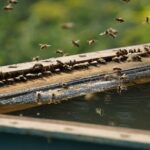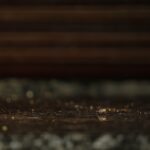In the captivating realm of social insects, there exists a hidden masterpiece of nature’s architecture – termite colonies. For over a decade, I have immersed myself in the enthralling world of termites as an experienced researcher and accomplished entomologist. With a deep-rooted passion for deciphering the intricate behaviors of these fascinating creatures, I have dedicated countless hours to unraveling the secrets behind termite queen behavior. In this article, we embark on a journey of discovery, as I peel back the layers of mystery to unveil the secrets of termite queen behavior, their reproductive strategies, and the complexities of their social hierarchy.

Uncovering the Secrets of Termite Queen Behavior
Termites may be small in size, but their social structures and behaviors are nothing short of fascinating. As an accomplished entomologist and researcher, I have dedicated over a decade to unraveling the secrets of termite queen behavior. In this article, we will explore the intricate world of termite queens and shed light on their vital role in maintaining colony harmony and sustainability.
The Royal Pheromone: A Key to Understanding Termite Queen Behavior
A recent study identified a royal-recognition pheromone and a king pheromone in termites, providing valuable insights into their behavior and social hierarchies.
Termites communicate through the use of pheromones, chemical signals that trigger specific responses in other members of their colony. This recent study, published in the National Center for Biotechnology Information, revealed the existence of a royal-recognition pheromone and a king pheromone in termites. These pheromones play a pivotal role in defining the behavior and status of termite queens and kings within the colony.
“Unveiling the secret chemical language termites use to identify their royalty, this study opens new avenues for understanding the complex social dynamics within termite colonies.”
Pushing the Limits of Parenthood: Termite Queens and Kings
Research conducted at the University of Florida on termite parental behaviors sheds light on how termite queens and kings push the boundaries of parenthood.
Termite queens and kings are not traditional parents as we know them. They exhibit extraordinary behaviors that challenge our understanding of parental care. In a groundbreaking study conducted at the University of Florida, researchers gained insights into these unique behaviors. Termite queens and kings go above and beyond, nurturing their offspring by regurgitating food and meticulously tending to their needs.
“By going beyond conventional notions of parental care, termite queens and kings redefine our understanding of dedication, ensuring the survival and prosperity of their colonies.”
The Antioxidant Secret: Unlocking the Longevity of Termite Royalty
A study published in PMC in 2021 revealed that termite queens and kings possess efficient antioxidant systems contributing to their impressive longevity.
Termite queens and kings are known for their extraordinarily long lifespans, which can reach several decades. But what keeps them alive and thriving for so long? A study published in PMC discovered an intriguing secret: their efficient antioxidant systems. These systems help minimize oxidative damage, allowing these royal insects to remain healthy and active for extended periods.
“By embracing the power of antioxidants, termite queens and kings defy the ravages of time, ensuring their continued reign within the colonies they govern.”
The Hierarchy of Termites: The Importance of Termite Kings
Termite kings play a crucial role in the hierarchy of termite colonies, as highlighted by The New York Times.
While termite queens may steal the spotlight, the influence and importance of termite kings in the colony hierarchy should not be overlooked. An article featured in The New York Times shed light on the significant role termite kings play in maintaining the social order within termite colonies. Their presence ensures the stability and fertility of the colony, making them essential contributors to the overall well-being of the termite society.
“Termite kings may not hold the same level of recognition as queens, but their role in the intricate web of termite society is indispensable, acting as pillars of strength and fertility.”
Genetic Influence: Unmasking the Rule of Termite Queens
A National Geographic article revealed how a single gene, Neofem2, influences the rule of termite queens.
Termites are governed by strict social structures, and their queens are no exception. The rule of termite queens is influenced by a single gene called Neofem2, as explored in a thought-provoking National Geographic article. This gene plays a crucial role in defining the behavior and dominance of termite queens within the colony.
“Within the seemingly chaotic world of termite colonies, the influence of Neofem2 defines the authoritative reign of termite queens, governing the fate of their colonies with precision.”
Queen Primer Pheromones: Maintaining Reproductive Dominance
According to a study published in the National Center for Biotechnology Information, termite queens maintain their reproductive dominance through the use of queen primer pheromones (QPPs).
Termite queens exert their control over reproductive processes through the use of queen primer pheromones (QPPs), as revealed in a study published in the National Center for Biotechnology Information. These chemical signals ensure the suppression of reproductive abilities in other female termites, maintaining the reproductive monopoly of the queen.
“With the strategic deployment of queen primer pheromones, termite queens maintain their iron grip on reproductive dominance, shaping the genetic destiny of their colonies.”
Recognition through Cuticles: The Language of Termite Queens and Kings
Behavioral assays outlined in a study published in the National Center for Biotechnology Information discovered the role of cuticular profiles in the recognition of termite queens and kings by workers and soldiers.
How do termite workers and soldiers recognize their queens and kings? A study published in the National Center for Biotechnology Information provided insights into this phenomenon. By analyzing the cuticular profiles of termite queens and kings, researchers uncovered the language embedded within their exoskeletons. This recognition mechanism ensures the preservation of the hierarchical order within termite colonies.
“Within the intricate world of termites, the language of recognition is elegantly etched into the cuticles of queens and kings, seamlessly guiding the actions of their loyal subjects.”
In conclusion, delving into the enigmatic world of termite queen behavior has been a deeply rewarding journey. Through years of extensive research and observation, we have uncovered the extraordinary strategies and behaviors that define termite queens. From the influence of pheromones and genes to the unique parental care and longevity mechanisms, these remarkable insects continue to inspire awe and admiration. By continuing to explore and understand the secrets of termite queen behavior, we not only enhance our knowledge but also gain valuable insights into the delicate harmony of the natural world.
Queen Termite Facts
Termites are fascinating creatures, but did you know that the queen termite is the true powerhouse behind the entire colony? If you want to learn more about these incredible queens and the fascinating facts surrounding them, click here for our detailed page on queen termite facts. From the incredible size of the queen to her ability to lay thousands of eggs each day, you’ll be amazed by what you discover. Don’t miss out on this opportunity to delve into the intriguing world of queen termites!

FAQ
Question 1
What is the recent study on termite behavior published in the National Center for Biotechnology Information (NCBI)?
Answer:
The recent study published in the National Center for Biotechnology Information (NCBI) identified a royal-recognition pheromone and a king pheromone in termites, shedding light on their behavior. This study defined royal-specific responses in termites, which will enable future research on termite behavior.
Question 2
What did the University of Florida’s study reveal about termite parental behaviors?
Answer:
The University of Florida conducted a study on termite parental behaviors, revealing insights into how termite queens and kings push the limits of parenthood. This study provided valuable information about the roles and responsibilities of termite parents in maintaining colony sustainability.
Question 3
What is the significance of termite queens and kings’ efficient antioxidant systems?
Answer:
According to a study published in PMC in 2021, termite queens and kings have efficient antioxidant systems that may contribute to their long lifespan. This finding highlights the physiological adaptations of these reproductive individuals and their importance in termite colonies.
Question 4
How much damage do termites cause to Australian homes each year?
Answer:
Termites cause more than $1.5 billion in damage to Australian homes each year, making them a significant problem in the country. This underscores the economic impact of termite infestations and the need for better understanding their behavior to develop effective prevention and control strategies.
Question 5
What is the role of the termite king in the hierarchy of termite colonies?
Answer:
The New York Times featured an article highlighting the importance of termite kings in the hierarchy of termite colonies. While the focus is often on termite queens, this article emphasizes the crucial role played by termite kings in maintaining colony dynamics and reproductive processes.












